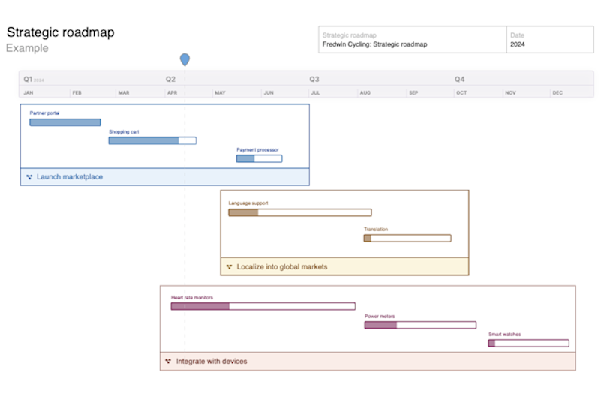Tools and templates for IT teams
Resources for IT assessments, IT strategy, and more
Last updated: May 2025
Today's IT teams are solution-driven. You deliver technology and services that meet current business needs and scale for the future. You support business growth — all while maintaining day-to-day support.
With all of this responsibility, IT teams have to work efficiently to solve problems and plan new initiatives. It helps to have a few tools handy to jump-start your thinking.
In this guide, we will share resources for three key areas — IT assessments, IT SWOT analysis, and IT strategy — along with some best practices. Together, these tools and templates will help you evaluate your current infrastructure and identify strategic opportunities to improve.
Manage strategic IT initiatives — try Aha! software.
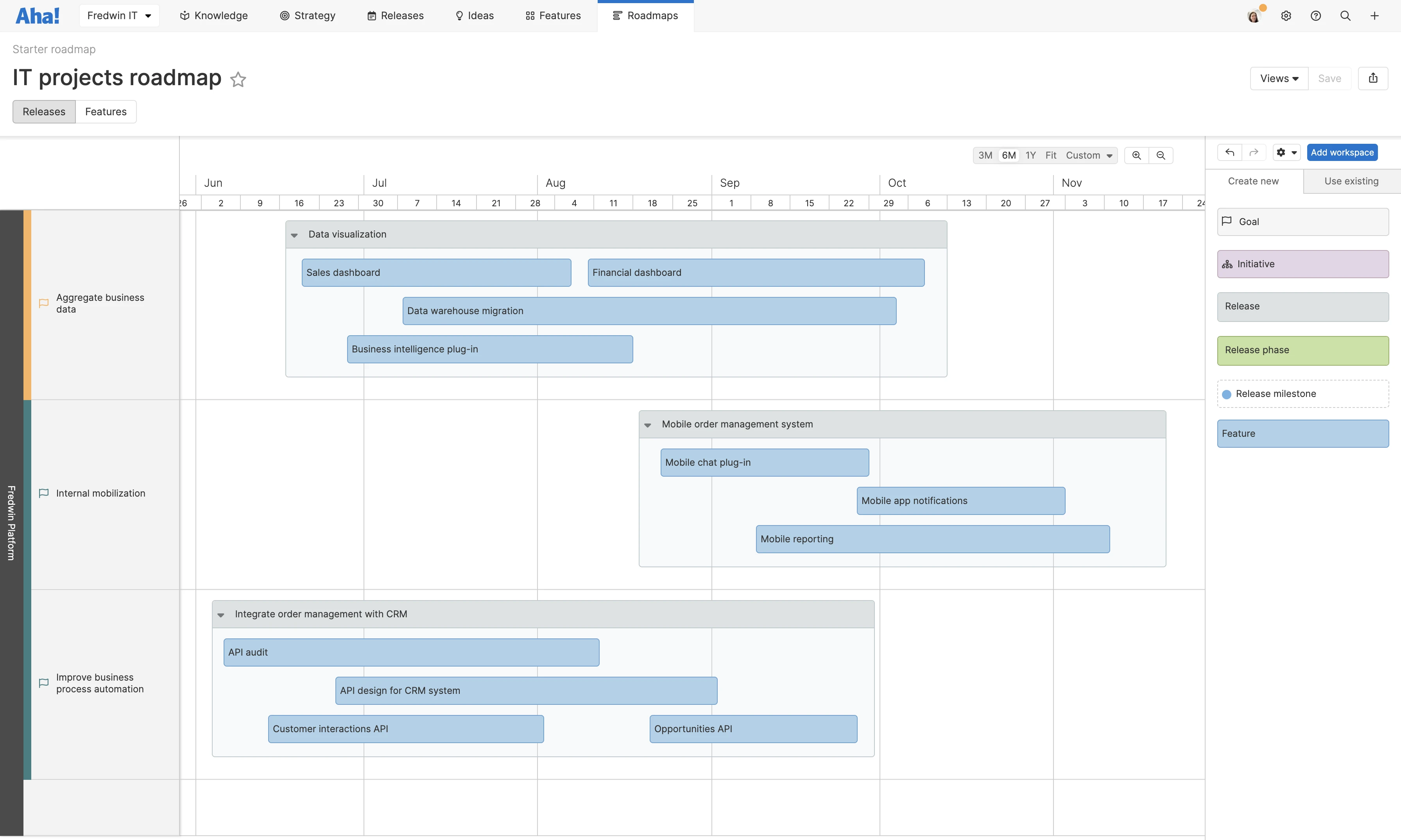
Let's dive in. Read on or jump ahead here:
What is an IT assessment?
An IT assessment is the formal process of analyzing all the data, systems, and procedures in your IT environment. It helps you evaluate the state of your infrastructure today — making it easier to identify critical areas to improve (such as outdated tools or missing policies). Most importantly, it gives you a clear view of where improvements are needed so you can prioritize and plan accordingly.
Many IT teams conduct IT assessments annually or biannually. Be sure to also reassess after any "triggering event," or something that could potentially disrupt or compromise systems and policies. A triggering event could include:
Embarking on an enterprise transformation
Migrating legacy systems to the cloud
Moving a data center
Opening or relocating to a new office space
Using an IT assessment checklist, or IT infrastructure checklist, helps you be thorough in this process. As a plus, review periods are smoother when you have a checklist as a guide.
What to include in an IT assessment checklist
Your IT assessment checklist should cover the key systems, tools, and processes your team manages — with a focus on performance, reliability, and risk. You will also want to review prior IT assessments and documentation for any issues that have not yet been resolved.
Use this example IT assessment checklist as a starting point:
IT strategy and performance |
|
Data and cloud storage |
|
Hardware and software capabilities and inventory |
|
System maintenance |
|
Risk management and compliance |
|
Workflows and other procedures |
|
You will want to customize your own checklist to your organization, industry, and unique needs. Once you do, the next step is to develop an action plan for addressing areas of need.
What is an IT SWOT analysis?
How do you decide what to do next? An IT SWOT analysis can help. This is a common way for IT teams to build a deeper understanding of the context you operate in: who your customers are, ways you can serve them better, and how you stack up against technology leaders in your industry.
A thoughtful IT SWOT analysis establishes how the technology you provide helps the organization achieve desired outcomes. This awareness supports all kinds of decisions you need to make as a department, from shaping your IT strategy to building the IT roadmap.
Components of an IT SWOT analysis
SWOT is an acronym that stands for strengths, weaknesses, opportunities, and threats. It is a popular business exercise. But you can complete a SWOT analysis for any functional area, including IT. You might even choose to complete one for each group within IT (for example, architecture, business intelligence, and security).
The table below summarizes how to do an IT SWOT analysis with examples:
Component | Purpose | Examples |
Strengths | Highlight the technical areas in which you excel. These can be related to IT infrastructure, methodologies, processes, or even technical skillsets. |
|
Opportunities | Detail areas for growth and expansion. These might include needs the organization does not currently meet and the business value of pursuing them. |
|
Weaknesses | Capture factors that put you at a disadvantage. Like strengths, these can be tied to infrastructure, methodologies, team processes, or skill sets. |
|
Threats | Identify areas of risk. The most obvious one for an IT department might be security risks, but they can also include any technology gaps or team behaviors that limit success. |
|
IT SWOT analysis template
There is nothing special about an IT SWOT analysis template. And that is what makes it effective — the concept is straightforward enough to apply to any team or function. This whiteboard template makes it simple to customize the matrix to your needs.
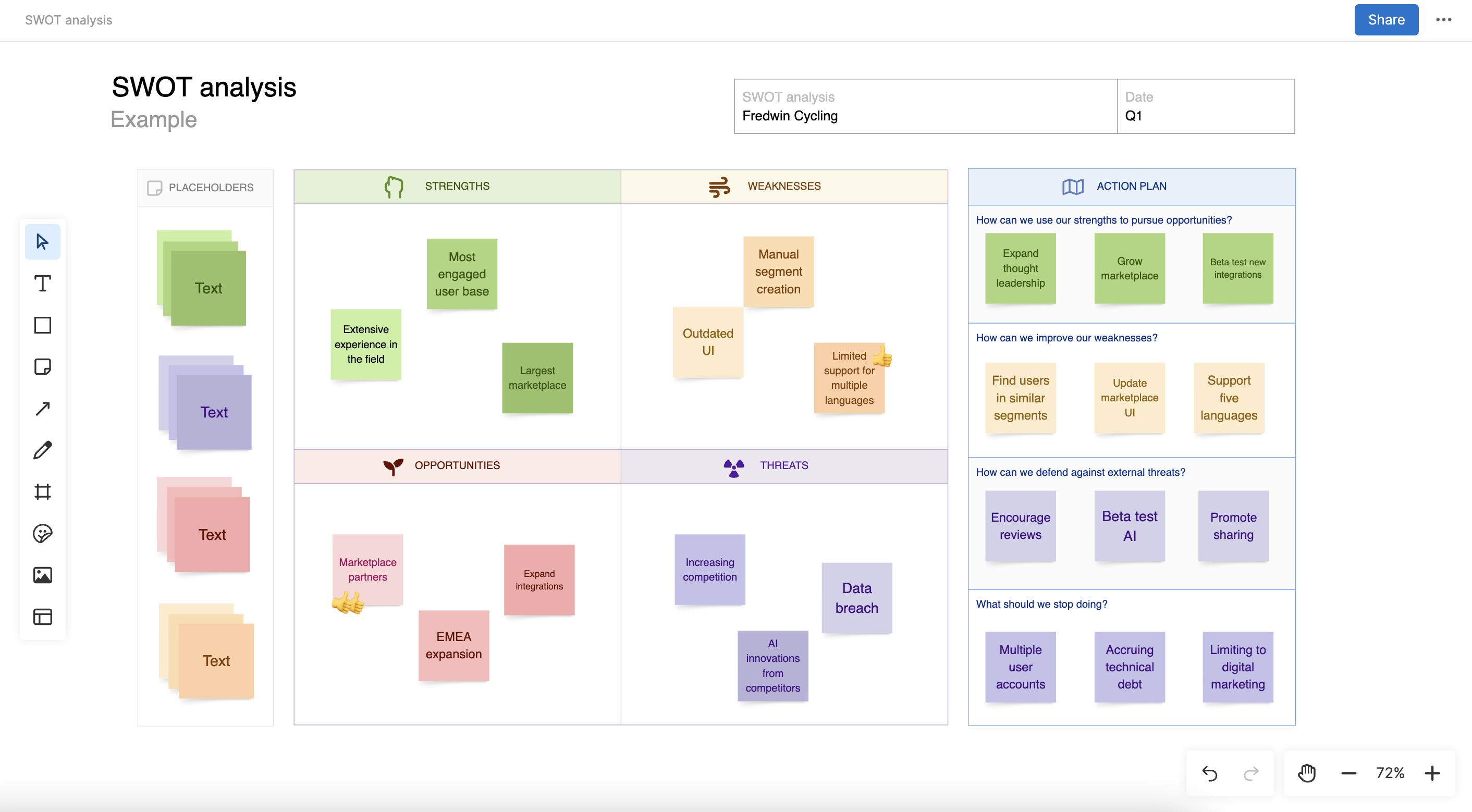
IT strategy templates
Once you assess the current state of your IT environment, as well as the internal and external factors that influence it, it is time to take what you learned and put it to work. The best way to do this is by revisiting your IT strategy.
IT strategy templates help you build out what you want to achieve: the big goals and initiatives that you want to prioritize in the near future. You can use the templates below to gain a high-level view of the team's direction, collaborate on the best way forward, and communicate that to the rest of the organization.
Related:
Fit gap analysis template
If you completed an IT assessment checklist and an IT SWOT analysis, you might have uncovered a need for new technology on your team. Use a fit gap analysis template to help you explore new tools and identify areas where they meet requirements ("fits") and where they fall short ("gaps").
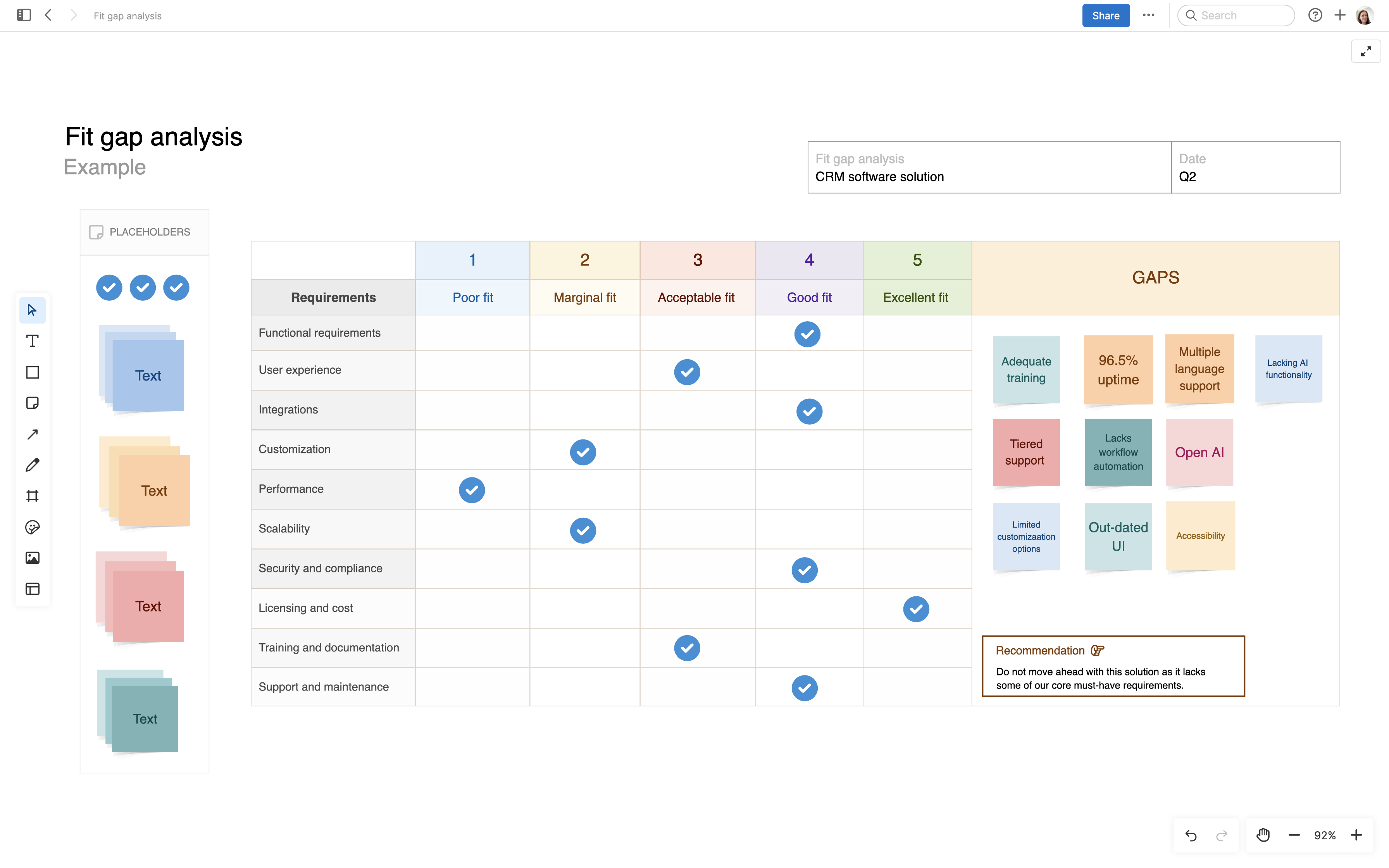
IT OKRs template
Goals help set your strategy in motion. Many IT teams use OKRs to clarify objectives and track measurable results. For example, you might set an objective to improve system reliability with a key result to reduce critical system downtime by 30%. Try it yourself with this OKRs template.
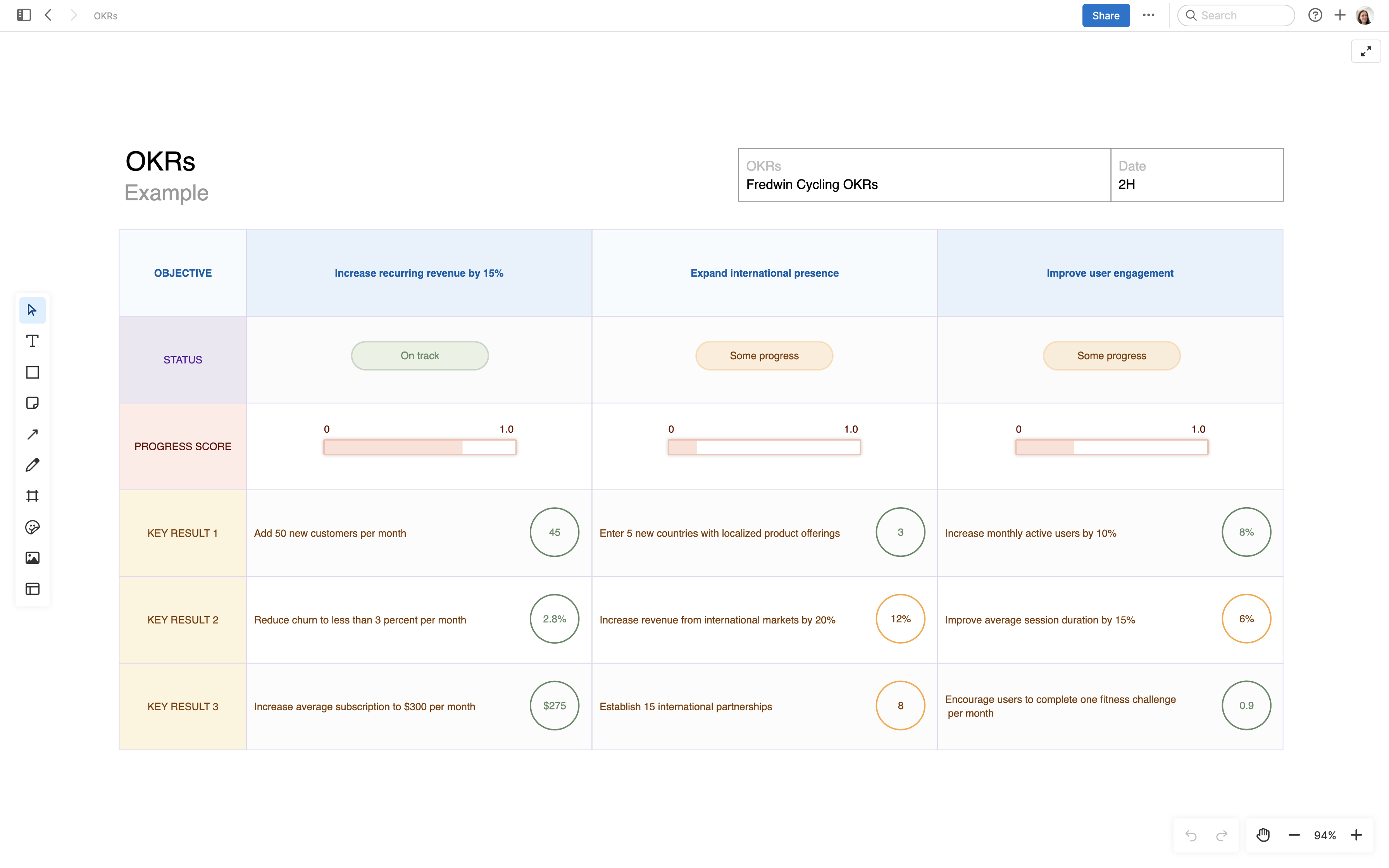
VMOST analysis template
It is easy to focus on technical fixes without stepping back to assess business impact — so it is important to weigh your priorities against business goals. A VMOST analysis template can assist here. Try it out to help connect IT tasks to strategic outcomes.

IT strategy roadmap template
This strategic roadmap template is great for timeline transparency. Use it to visualize key initiatives and priorities, such as a major system upgrade. This can help you communicate how your technical plans align with business goals and keeps everyone focused on what matters most.

Use our IT checklist and templates to quickly assess where you are at and explore what is next. Then, when you are ready to formalize your IT strategy, try Aha! Roadmaps to track your progress with a strategic IT roadmap. You can also use Aha! Teamwork to help manage all of the IT projects you plan to deliver.


